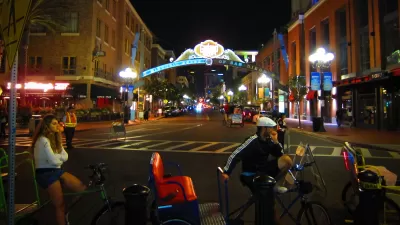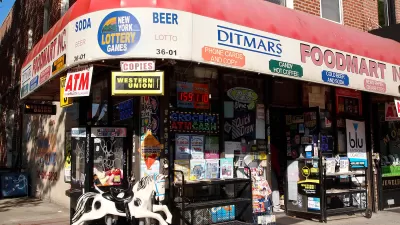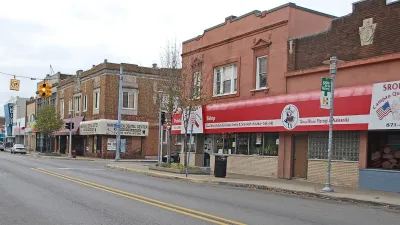Traffic diverters can be designed as a hybrid of permeable greenways and woonerfs to make walking and biking easier, safer, and even more pleasant than driving.
Blogger Shaun Jacobsen celebrates the unintended benefits of a one-way street that has been closed to traffic due to construction: "With so little car traffic, people feel fine crossing wherever they want, or diagonally at intersections. It’s positively pleasant to ride a bicycle…because there’s so little cut-through car traffic."
Though the resulting pedestrian- and bicycle-friendliness, or what Jacobsen refers to as "filtered permeability," is an unintentional result of road construction on his one-way street, Jacobsen recognizes that other streets could benefit by intentionally placing "car traffic diverters": "The best part about making it harder for thru car traffic is that it still permits local traffic to get where it needs to go; longer trips are diverted to arterial roads, keeping drivers off of residential streets, opening them up to people (including families with children) who want to bike safely to the store, the park, and so on...it’s a way to make it easier to make those one- or two-mile trips by a way other than driving there."
To formalize this pedestrian- and bicycle-prioritized flow, Jacobsen recommends, "it should be policy to bring the entire street to the level of the curb and introduce permeable pavement/bioswales for stormwater management, making the street a sort of greenway-woonerf hybrid." He provides a diagram to illustrate his point and notes, "This solution isn’t one designed to get people riding bikes or walking long distances, like to work downtown, but it’s a way to make it easier to make those one- or two-mile trips by a way other than driving there."
FULL STORY: Let’s start blocking off residential streets

Alabama: Trump Terminates Settlements for Black Communities Harmed By Raw Sewage
Trump deemed the landmark civil rights agreement “illegal DEI and environmental justice policy.”

Study: Maui’s Plan to Convert Vacation Rentals to Long-Term Housing Could Cause Nearly $1 Billion Economic Loss
The plan would reduce visitor accommodation by 25% resulting in 1,900 jobs lost.

Planetizen Federal Action Tracker
A weekly monitor of how Trump’s orders and actions are impacting planners and planning in America.

Wind Energy on the Rise Despite Federal Policy Reversal
The Trump administration is revoking federal support for renewable energy, but demand for new projects continues unabated.

Passengers Flock to Caltrain After Electrification
The new electric trains are running faster and more reliably, leading to strong ridership growth on the Bay Area rail system.

Texas Churches Rally Behind ‘Yes in God’s Back Yard’ Legislation
Religious leaders want the state to reduce zoning regulations to streamline leasing church-owned land to housing developers.
Urban Design for Planners 1: Software Tools
This six-course series explores essential urban design concepts using open source software and equips planners with the tools they need to participate fully in the urban design process.
Planning for Universal Design
Learn the tools for implementing Universal Design in planning regulations.
Caltrans
Smith Gee Studio
Institute for Housing and Urban Development Studies (IHS)
City of Grandview
Harvard GSD Executive Education
Toledo-Lucas County Plan Commissions
Salt Lake City
NYU Wagner Graduate School of Public Service





























